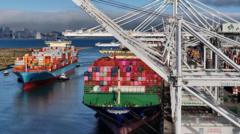In the wake of significant trade negotiations, President Donald Trump has activated expansive tariffs impacting more than 90 nations. Announced late last night on his Truth Social platform, Trump claimed that these tariffs are generating billions in revenue for the U.S. economy while aiming to restore jobs and manufacturing domestically. Moreover, he has threatened steep increases in tariffs for certain countries, such as a potential 50% tariff on goods from India unless it halts purchasing oil from Russia, and a staggering 100% on foreign computer chips to draw tech investment back to the U.S.
These international tariffs are part of Trump's overarching strategy to rectify what he perceives as an unjust global trading landscape. Central to this strategy is a commitment to reducing the trade deficit—reflecting the gap between U.S. imports and exports. The tariffs levy a charge on U.S. importers for goods acquired from abroad, a cost that may trickle down to consumers.
As the overall average tariff rate in the U.S. reaches its peak in nearly a century, the introduction of these duties on Thursday follows months of uncertainty in international markets. Economists noted a semblance of stability in Asian markets following the announcement, with some countries, such as the UK and Japan, negotiating lower tariff rates to mitigate potential impacts.
Countries that heavily rely on exports, especially in Southeast Asia, are feeling the strain, with Laos and Myanmar facing tariffs as high as 40%. While some nations have made deals with the U.S. to avoid climbing tariff rates, Switzerland meets a particularly challenging 39% tariff rate, potentially shaking its economy. The situation remains dynamic, as President Trump continues to expand tariffs on key trading partners like Canada and Mexico over a range of political objectives.
Just last week, Trump raised tariffs on Canadian goods from 25% to 35%, citing drug trade concerns, while negotiations with Mexico are ongoing, pausing heightened tariffs for the moment. Moreover, as the U.S. and China embark on extended discussions and navigate a fragile tariff pause, uncertain outcomes loom.
In an additional twist, Trump's tariff policies intertwine with efforts to address Russia’s war in Ukraine. By potentially targeting nations that engage in trade with Russia, including an imposed 50% tariff on Indian imports if oil trades continue, analysts suggest other countries could become wary. Against this backdrop, Apple's recent announcement of a $100 billion investment further exemplifies Trump's push for heightened domestic production, especially in semiconductors, amid looming tariffs.
With ongoing tensions in the global trade landscape, the ramifications of Trump's tariff strategies will continue to unfold in various dimensions, affecting countries and businesses worldwide.
These international tariffs are part of Trump's overarching strategy to rectify what he perceives as an unjust global trading landscape. Central to this strategy is a commitment to reducing the trade deficit—reflecting the gap between U.S. imports and exports. The tariffs levy a charge on U.S. importers for goods acquired from abroad, a cost that may trickle down to consumers.
As the overall average tariff rate in the U.S. reaches its peak in nearly a century, the introduction of these duties on Thursday follows months of uncertainty in international markets. Economists noted a semblance of stability in Asian markets following the announcement, with some countries, such as the UK and Japan, negotiating lower tariff rates to mitigate potential impacts.
Countries that heavily rely on exports, especially in Southeast Asia, are feeling the strain, with Laos and Myanmar facing tariffs as high as 40%. While some nations have made deals with the U.S. to avoid climbing tariff rates, Switzerland meets a particularly challenging 39% tariff rate, potentially shaking its economy. The situation remains dynamic, as President Trump continues to expand tariffs on key trading partners like Canada and Mexico over a range of political objectives.
Just last week, Trump raised tariffs on Canadian goods from 25% to 35%, citing drug trade concerns, while negotiations with Mexico are ongoing, pausing heightened tariffs for the moment. Moreover, as the U.S. and China embark on extended discussions and navigate a fragile tariff pause, uncertain outcomes loom.
In an additional twist, Trump's tariff policies intertwine with efforts to address Russia’s war in Ukraine. By potentially targeting nations that engage in trade with Russia, including an imposed 50% tariff on Indian imports if oil trades continue, analysts suggest other countries could become wary. Against this backdrop, Apple's recent announcement of a $100 billion investment further exemplifies Trump's push for heightened domestic production, especially in semiconductors, amid looming tariffs.
With ongoing tensions in the global trade landscape, the ramifications of Trump's tariff strategies will continue to unfold in various dimensions, affecting countries and businesses worldwide.


















